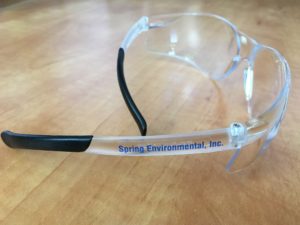The August HAZWOPER Challenge is now closed. Thank you for participating. Please come back September 1st for our next HAZWOPER Challenge!
Changes coming to NAAQS for PM2.5!
On January 6, 2023, EPA published a proposed rule for particulate matter National Ambient Air Quality Standard (NAAQS) that would retain the primary 24-hr PM2.5 standard (35 µg/m3) and reduce the annual standard from 12 µg/m3 to 9 µg/m3. The agency is also taking comments on reducing the 24-hr PM2.5 standard as low as 25 µg/m3 and the annual standard as low as 8 µg/m3. The Clean Air Act requires that EPA review the NAAQS every five years to ensure their adequacy. The last review of the PM NAAQS was completed in December 2020 with no change, but EPA announced their decision to reconsider this action in June 2021. Although no changes to the PM10 NAAQS standard are expected at this time, changes to the PM2.5 NAAQS standard are proposed.
This proposal takes into account thousands of scientific studies since the last update of PM NAAQS in 2012 that have demonstrated the dangers of long term soot exposure. The evidence supports a likely relationship between long-term PM2.5 exposure and respiratory effects, nervous system effects, and cancer. EPA estimates that if finalized, a strengthened annual PM2.5 standard of 9 µg/m3 would:
- Prevent up to 4,2000 premature deaths per year;
- Prevent 270,000 lost workdays per year; and
- Result in as much as $43 billion in net health benefits in 2032.
EPA accepted public comments on the proposed rule through March 7th and has already held public hearings. Additional information will be made available on the National Ambient Air Quality Standards (NAAQS) for PM webpage.
State, local, and tribal air agencies will be required to use this standard after it is finalized federally. Once in effect, this will cause more difficulty when emission units require PM2.5 modeling as part of a permit application or modification. Several areas throughout the Pacific Northwest have high particulate background concentrations, which will narrow the allowable “new” particulate emitted even further. If you are planning any facility expansions or new sources that include particulate matter emissions and want to know if this rule would effect your business, please contact Spring Environmental for more information.
Permanent Outdoor Heat Exposure Rules Approved!
On June 27, 2023 Washington State Department of Labor & Industries (L&I) adopted the revised permanent rules for Worker Outdoor Heat Exposures. Washington has been operating under emergency rules during the last two summers while the permanent rule was being developed. With the approval, the new regulations went into effect July 17, 2023.
In the new guidance, employers and employees will find new and updated information to protect workers while working in outdoor heat conditions. The new standards will apply year-round when the action levels outlined in Table 1, 52oF for non-Breathable clothing and 80oF for all other clothing, are exceeded. Some additions and revisions that were made include:
• New/updated definitions
• Response to heat induced illnesses
• Information and Training program requirements
• Shade requirements
• Acclimatization guidelines
For more information, check out our regulatory update fact sheet or Be Heat Smart (wa.gov) for access to resources such as posters, videos, and training materials.
* The Federal rulemaking for Heat Illness Prevention in Outdoor work settings is currently in the Pre-rule stage of development.
July HAZWOPER Challenge
Spokane Area Burn Ban (6/30/2023)
Burn restrictions have been put in place by Fire Marshals from the Spokane Valley Fire Department (SVFD), City of Spokane Fire Department (SFD), Spokane County, City of Cheney, City of Airway Heights, and City of Deer Park as of June 30th, 2023, at 12:01 am.
Unauthorized open burning and unauthorized recreational fires are restricted until this order is lifted or unless otherwise permitted by law enforcement or authorized agencies. Manufactured portable outdoor devices are allowed and appropriate fuels in appropriate devices are also allowed. Designated campfires in parks and campgrounds may be allowed as approved and determined by agencies with jurisdiction. Confused? Check out this flyer for the quick Do’s and Don’ts of burning.
Spokane Fire Department (SFD) Fire Marshal, Lance Dahl provided some guidelines for a safe fire season below:
Only burn in approved devices.
Have a fire extinguisher and/or a hose accessible.
Be kind to your neighbors and only burn clean dry wood.
Remember to watch for burn restrictions related to our smoke particulate index.
Current restrictions can be found at https://spokanecleanair.org/burning/burn-restrictions/ or the Burn Info Hotline at (509) 477-4710.
Pregnant Workers Fairness Act (PWFA) Goes Into Effect
On June 27, 2023, the Pregnant Workers Fairness Act that was signed into law in December 2022 went into effect. Under the law, the PWFA requires “Covered employers” to provide “reasonable accommodations” for the workers limitations during pregnancy unless the accommodation will cause the employer undue hardships. According to U.S. Equal Employment Opportunity Commission (EEOC), “Covered employers include private and public sector employers with at least 15 employees, Congress, Federal agencies, employment agencies, and labor organizations.” Some examples of reasonable accommodations that may be explored include:
• Altering scheduled break routines
• Changing of work schedules
• Variances to food and/or drink policies
• Scheduling for medical appointments or childbirth recovery
Click here to review additional information regarding the PWFA and for access to resources such as posters, videos, and training materials.

